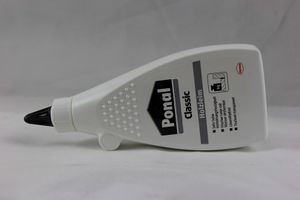Material:Wood Glue: Difference between revisions
From CoMakingSpace Wiki
(Created page with "Wood glues are adhesives for bonding wood and similar materials (e.g. paper) together. Some engineered woods may not work well due to their ad...") |
(general advice) |
||
| Line 2: | Line 2: | ||
Also have a look at this [http://www.highlandwoodworking.com/wood-glue-types-and-uses.aspx neat intro to wood glues]! | Also have a look at this [http://www.highlandwoodworking.com/wood-glue-types-and-uses.aspx neat intro to wood glues]! | ||
== General Advice == | |||
* do a dry arrangement before applying glue to complicated assemblies - that way you'll be sure to have everything ready to go when the clock starts ticking | |||
* glue bonds need pressure - best clamp them from all possible sides and restrain them in as many directions as you can to prevent sliding | |||
== Helpful Accessories == | == Helpful Accessories == | ||
* put some foil (or cheap [[Adhesive Tape|adhesive tape]]) under your workpiece to avoid gluing it to the table | * put some foil (or cheap [[Adhesive Tape|adhesive tape]]) under your workpiece to avoid gluing it to the table | ||
* [[Q-Tips|Q-tips]] or a mini roller are great for distributing the glue evenly | * [[Q-Tips|Q-tips]] or a mini roller are great for distributing the glue evenly | ||
* [[clamps]] should be used whenever possible, especially if your parts are very light (heavier parts may press on the bond themselves) | * [[clamps]] should be used whenever possible, especially if your parts are very light (heavier parts ''may'' press on the bond themselves) | ||
== Important Workpiece Properties == | == Important Workpiece Properties == | ||
Revision as of 16:26, 25 January 2018
Wood glues are adhesives for bonding wood and similar materials (e.g. paper) together. Some engineered woods may not work well due to their additives, but with actual wood the bond you can achieve is often stronger than the individual pieces.
Also have a look at this neat intro to wood glues!
General Advice
- do a dry arrangement before applying glue to complicated assemblies - that way you'll be sure to have everything ready to go when the clock starts ticking
- glue bonds need pressure - best clamp them from all possible sides and restrain them in as many directions as you can to prevent sliding
Helpful Accessories
- put some foil (or cheap adhesive tape) under your workpiece to avoid gluing it to the table
- Q-tips or a mini roller are great for distributing the glue evenly
- clamps should be used whenever possible, especially if your parts are very light (heavier parts may press on the bond themselves)
Important Workpiece Properties
Wood is a natural material and every piece is unique, but there are a few basic things to consider:
- don't glue onto end grain, it won't be strong!
- possible alternatives: pocket hole jig & screws or corrugated fasteners (for frames); proper joinery.
- if you want to laminate several pieces into a plate, joint the edges
- saws don't give you perfectly straight and perpendicular edges
PVA Glue
| MaterialInfoBox PVA Glue | |
|---|---|

| |
| Synonyms: | polyvinyl acetate, carpenter's glue, white glue; DE: PVAC (Polyvinylacetat), Weißleim, "Holzkleber", "Holzleim", "Ponal Classic" |
| Suggested Tools: | silicone brush, fingers, clamps |
PVA glue is a widespread synthetic resin based wood glue and probably the one you're thinking of first when you hear "wood glue".
The bottle should be stored laying on its side to keep the tip wet - no plug is supposed to form then [1].
Removal
Is this adhesive removable? Please add your experiences below!
- heat: ?
- water: only right after application (e.g. squeeze-out)
- other solvents: ?